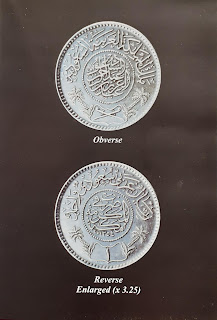Mayday, Mayday! August 28, 1944. Silhouetted against the moon, the S.S. John Barry sank under the waves of the Arabian Sea, victim of a German U-Boat's torpedoes. Fifty years later, in a unique rescue operation 2600 meters below sea level, the secrets of this vessel were revealed. S.S. John Barry had sailed from America, bound for the Middle East, laden with cargo of such a secret nature that the crew onboard were unaware of all the contents. It was towards the end of the Second World War and the ship was carrying military supplies, but there were rumours of something far more valuable being onboard. The cargo was a vast shipment of silver coins, destined to become a treasure of the past.
In the midst of World War II, a severe shortage of silver in the kingdom of Saudi Arabia had forced King Abdul Aziz to convert some of his oil revenues into hard currency. As a result, he ordered the minting of 3 million silver one-riyal coins from the United States.
In November 1994, 1.4 million of these coins were successfully removed from the ship's hold no. 2. Of this, only 80,000 remain (as in 1994). The rest were melted down. The story of their recovery is one of meticulous historical detective work combined with the latest in technology.
Fact File: In June 1944, the 7172-ton vessel S.S. John Barry, captained by Joseph Eller ward, embarked on a special mission to deliver a top-secret consignment to the Middle East. Its first port-of-call was New York, where it was loaded with a British Lend Lease cargo destined for what was known as the "Red Sea Account". On June 29, amongst great security, a secret cargo was loaded on to the ship. Many claim that this was 1200 tons of silver bullion valued at $26 million dollars at 1944 rates. With this onboard, S.S. John Barry sailed for Philadelphia for its final loading oil refinery supplies, war material and 3 million Saudi riyals.
Note from the Treasury Department, United States Mint Service, Philadelphia, addressed to Treasury Department, Washington, dated July 15, 1944, regarding 3 million Saudi riyals.
Thus, on 24 July 1944, with a full cargo, the Liberty ship sailed from Hampton Roads, Norfolk. She crossed the Atlantic in a convoy, avoiding the paths of German submarines. The vessel's itinerary took her through Port Said, Egypt, on August 18 into the Suez Canal. From there, she continued on to Aden with her sights set on Ras Tanurah on the east coast of Saudi Arabia. On a zig-zag course and in radio silence, she sailed through the Arabian Sea.
But her final destination was never reached. Off the coast of the Sultanate of Oman, she found herself up against Kapitan Lieutenant Johann Jebson, captain of German U-Boat U859. Its torpedo exploded into the starboard side of the Liberty ship, between holds no. 2 and 3. The third torpedo ripped into the port side between hold no. 3 and the engine room. The bow broke away from the stern and disappeared into the watery depths of the ocean. Astonishingly, only two lives were lost.
On 29 August, survivors were picked up and interviewed. The reports of the captain and purser confirmed that the ship was carrying more than just war supplies. Documented as "other cargo", the silver coins were stowed in hold no. 2.
Fifty years later, the US government sold its rights to the wreck to an Omani-British group, Blue Water Recoveries Ltd. In 1990, the task of recovering the cargo of S.S. John Barry got underway. Never before had a salvage operation of this magnitude been undertaken at such a depth. It took three years to rescue the coins from the watery depths and involved some of the most technically sophisticated equipment ever used underwater.
In November 1992, using automated equipment similar to that used in locating the Titanic, the salvage operators finally tracked down the grave of S.S. John Barry. However, it was in November that the builders' nameplate for the bridge and closer inspection revealed that hold no. 2 was intact. The recovery began. It took the specially designed recovery grab 7 days to clear the decks, gain access to the holds and bring to the surface the coins and their containers.











No comments:
Post a Comment
Any inputs or feedback is welcome!